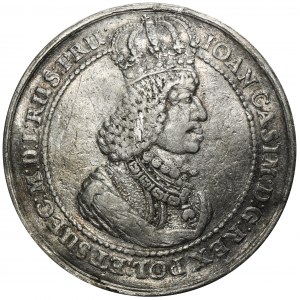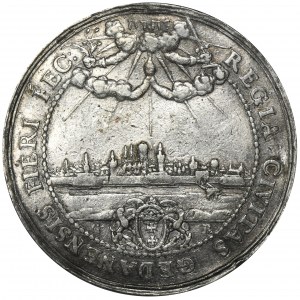The highest rarity numismatic coin during the minting of John II Casimir.
A majestic donative in silver struck at the Gdansk mint with the stamps of Jan Hoehn the Elder. The stamps with which it was struck were also used to strike a 10-ducat (Dutkowski G387) and an 8-ducat (Dutkowski G388) donative.
Background with numerous bruises, details correct.
On the obverse we have the traditional representation of a monarch wearing a crown, with the Order of the Golden Fleece on his chest. The inscription in the rim is also conventional: IOAN CASIM D G REX POL ET SUEC M D L RUS PRU.
Much more interesting is the reverse. Note the innovative depiction of the city's size and grandeur. It is no longer - as in the time of Sigismund Vasa - a drawing of only the city coat of arms. We are dealing here with a much more sophisticated propaganda message. The coat of arms of Gdansk, of course, also found itself on the reverse (on the sides of the coat of arms the initials "G - R" of the mint manager Gerhard Rogge).The most impressive element of the drawing of the reverse, however, is the magnificent city panorama (with the most characteristic buildings recognizable). Above it floats a wreath of clouds, through which the sun's rays pierce. Four hands emerge from the clouds: two at the bottom in a gesture of prayer, one at the top left with an olive branch (symbol of glory, peace and prosperity) and a palm branch (symbol of triumph and majesty) and one hand at the top right with a sword and a scale (symbols of strength and justice). Above them was placed the Hebrew name of God - IAHWE. The inscription in the rim also celebrates Gdansk as the commissioner of this magnificent donation: REGIA CIVITAS GEDANENSIS FIERI FEC.
Jan Kazimierz's donations are items for the most advanced collections. Looking through the available archives, one can note single ones in gold, but notations of those struck in silver are even more scarce. A numismat of the highest rarity, whose rarity pushes the far from ideal state of preservation into the background.
Obverse: bust of the king to the right
IOAN CASIM D G REX POL ET SUEC M D L RUS PRU
Reverse: panorama of the city, below the coat of arms of Gdansk and the letters G-R
REGIA CIVITAS GEDANENSIS FIERI FEC
Diameter 48 mm, weight 24.26 g
Donations are numismats that have the characteristics of both a medal and a coin. They were minted mainly in gold (multiples of a ducat), much less frequently in silver. Donativas were issued by the great cities of the Republic - Gdansk, Elblag, Torun and Riga - as special gifts to a monarch visiting a particular city. This was an excellent way to curry favor with the king, and at the same time an excellent opportunity to advertise one's city and spread the virtues of its inhabitants. Perhaps not everyone knows, but the very concept of the donative is a later one. In the era in which these works were created (16th-17th centuries), the terms "gold" or "gold pieces" were used.
It so happened that over the course of the seventeenth century, the most outstanding of the artists who made up the history of Polish medal-making were active in Gdansk. Among them, Jan Hoehn the elder - the author of the discussed numismat - held a leading position in his period.
At the beginning of the reign of Jan Kazimierz, an ambitious attempt at monetary reform took place (1650). A ban on the circulation of foreign money was introduced and the issuance of good money of its own began. It was then that copper shekels (wide) first appeared. The assumptions of the reform proved unrealistic so it was quickly withdrawn. Meanwhile, in Lithuania, which did not feel obliged to implement the 1650 reform (its representatives did not participate in the work of the commission), a parallel reform was introduced, based on other principles. In view of the Moscow invasion, the Vilnius mint worked only in 1652-1653. In turn, under the conditions of the Swedish deluge, an important episode in the history of Polish minting was the launch of a makeshift crown mint in Lviv (1656-1657). The monetary relations of the Commonwealth tried to put in order the ordinance of 1658. The most notable for the period of the reign of Jan Kazimierz were the issues of subvalue money: small copper crown and Lithuanian shekels (so-called boratins) minted in the number of about 2 billion pieces, and zlotys (so-called tymfs), with an official value of 30 pennies - more than twice the actual silver content of the coin. Of the municipal mints in the period in question, there were mints in Gdansk, Elblag and Torun. John Casimir also exercised his minting rights as Prince of Opole and Racibórz (three-carat coins were minted at the Opole mint).









